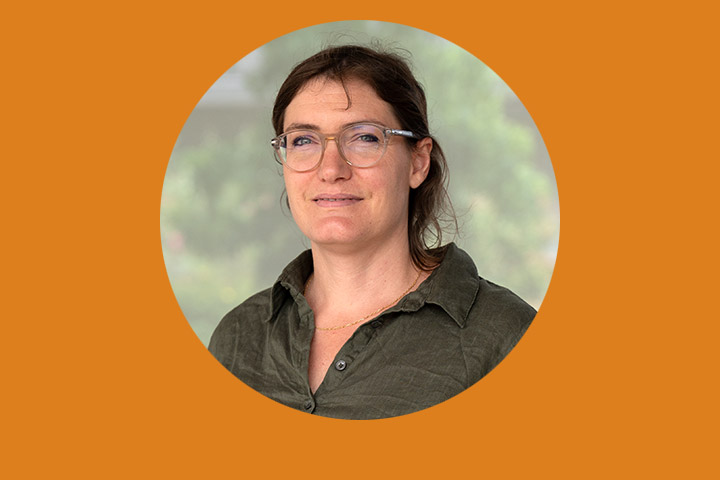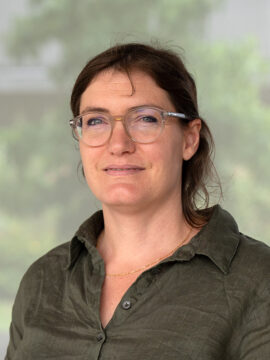
Interview: Fuschia Serre

Fuschia Serre is a researcher at SANPSY Laboratory. She has been studying addiction in humans since 2008. The aim of her research is to gain a better understanding of the mechanisms of relapse and to improve addiction treatment, in particular through a mobile application, Craving-Manager, currently in a clinical trial phase.
Bordeaux Neurocampus: You started your career in Serge Ahmed’s team. How did you make the transition from animal to human research?
Fuschia Serre:
After studying biology in Toulouse, I wanted to join the Neuroscience Master’s program at the University of Bordeaux because addiction was a subject that had interested me for a long time. This enabled me to join Serge Ahmed’s team, where I had the opportunity to take part in Magalie Lenoir’s experiments in 2006. In summary, her work showed that most rats considered to be expressing an addiction behavior turned away from cocaine, in favour of an alternative reward, water sweetened with saccharin, when given the choice. This study aroused a great deal of interest when it was published, and still does to this day. It really was a superb experience.
Then, I wanted to get closer to addiction as it is naturally expressed in humans, by joining Marc Auriacombe’s Team at SANPSY laboratory. I defended my thesis in 2012 under the supervision of Marc Auriacombe, as part of a collaborative project with Mélina Fatseas and Joel Swendsen. The aim was to adapt the EMA (Ecological Momentary Assesment) methodology, introduced in Bordeaux by Joel Swendsen, to the study of addiction and in particular craving.
How does this EMA methodology work?
We are interested in understanding what makes it so difficult, in everyday life, to stop using substances, and what is the influence of this driving force, called ‘craving’, in pushing people to relapse despite experimenting adverse consequences of use and expressing motivation to abstain or reduce use.
We are offering people being treated at the addiction treatment center at Charles Perrens Hospital the opportunity to take part in a research study. They are given a mobile phone on which electronic questionnaires are administered several times a day for 14 days.
The first advantage of this methodology is that we can explore phenomena, as they occur naturally in daily life. The second advantage is that we can measure craving as it occurs. It’s always more complicated for participants to remember the intensity of a craving episode at a precise moment when they’re only questioned once or twice a month, whereas with this method it’s on a daily basis.
Finally, these questionnaires, repeated several times a day, will make it possible to see fluctuations in craving intensity over the course of a day, for each individual, and also to highlight prospective links. For example, can an event that occurred during the morning questionnaire statistically predict the event measured during the following lunchtime assessment?
Using this method adapted to craving, the main results of my thesis highlighted what we call the “Cues – Craving – Use” model. Cues are conditioned stimuli that can trigger craving. For example, if every time you go out on your balcony you smoke a cigarette, your balcony may acquire the ability to trigger cravings, even if you don’t want or intend to smoke a cigarette.
So these results show that craving can be predictive of a possible relapse?
Yes, and that’s very important: we have a target for treating addiction and reducing the risk of relapse.
But to do this, we need to measure craving accurately, and the EMA method (answering questionnaires several times a day) can be burdensome over the long term. We therefore wondered whether craving could be associated with physiological markers that could be measured without the need for the individual to report it.
Emmanuelle Baillet, who has just defended her thesis at SANPSY, has set up a method for integrating the EMA with a wearable wristband, for constant measurement of physiological parameters in everyday life (heart rate, skin conductance, temperature, etc). This study highlighted a pattern of physiological responses specific to craving, based on this continuously collected data, paving the way to biomarkers of craving.
Do you aim to transfer these research results into potential treatments?
Yes, our aim is to improve addiction treatments. We are fortunate to be attached to the Charles Perrens Hospital, which supports us in using our research findings to develop new treatments.
At SANPSY, we have already developed the KANOPEE application, which explores the use of tobacco, alcohol, cannabis and screens, as well as sleep. It is designed for early detection, brief intervention and medical referral. It is available free of charge and has been a great success (over 40,000 downloads).
But we want to go further. We’ve had a lot of positive feedback from participants in our EMA studies. We realized that these regular questionnaires could be seen as a help, a support, by increasing awareness of their situation in their daily lives, and that they wanted to continue beyond the study.
We therefore decided to develop a new mobile application, Craving-Manager, that would be tailored to these expectations: an application that measures at-risk situations, asks questions but goes further, giving individualized ‘therapeutic’ advices on a daily basis to help people cope with craving, even anticipate it, and thus reduce the risk of relapse.
This application is currently being evaluated in a randomized controlled clinical trial and we are collaborating with SANPSY’s Digital Axis, which is particularly interested in the factors that contribute to acceptability of digital tools in health, which is a major challenge.
Would you like to make Craving Manager available to a wider audience?
Yes, in the long term, our aim is to offer a new form of treatment that is accessible to as many people as possible, especially those who don’t take the step of contacting a health professional for help for their addiction.
We have begun a study to assess the effectiveness of the application, and we plan to include two hundred and forty participants in six centers in France. Eventually, the current research version of the application will be adapted to meet requirements to be registered as a medical device.
Other applications already exist, but what emerges from the literature is that very few have been scientifically validated. So we prefer to go through all the stages and come up with a truly effective application, even if it takes longer to see the light of day.
Interview by Julien Campet
Last update 20/12/23
